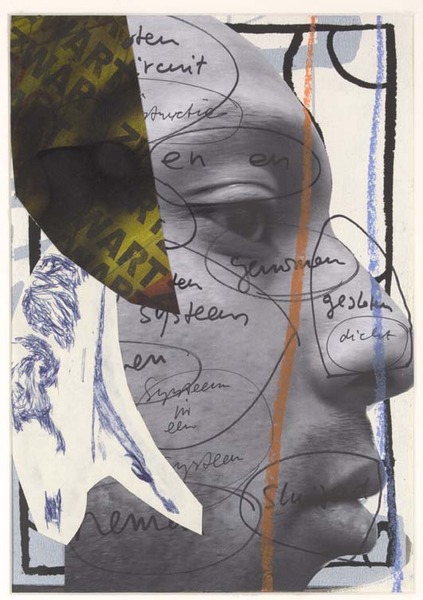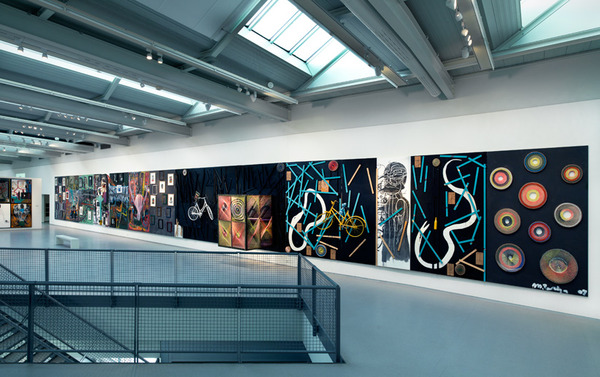Honestly, I've never been a big fan of Cobra and their brand of playful semi-figuration, although that is primarily due to me not really being a painting guy (to stay within the movement, I'd take one of Robert Jacobsen's primitivism-infused industrial artifacts over a Karel Appel painting any day). As geographically de-centered as the group of artists involved was (Copenhagen-Brussels-Amsterdam, hence the name), their legacy lives on in Amstelveen's Cobra Museum. And, it turns out, the movement’s spirit echoes in contemporary art today in ways that resonate with me more than the original corpus does.
Visiting the Michael Tedja solo show at the Amstelveen venue makes the connection apparent: although the Surinamese-Dutch artist is evidently more inspired by Jean-Michel Basquiat's urban energy, and he embeds his own work into a more rigorous conceptual matrix, and a creative urge similar to the one animating Cobra art can be sensed throughout.

Michael Tedja, Sssssssssnake, 2011; © Michael Tedja, courtesy Galerie Nouvelles Images, Den Haag / Photo: Hennie van Beek.
The difference is Tedja's pieces feel way more urgent. On one hand the artist indulges in a wider and more eclectic use of media, appropriating with Rauschenbergian voracity tridimensional objects in his compositions (the term “painting” doesn't really apply here). Wood planks, bike tires, thread, even small (and less small) sculptures. Some of the latter depict black Santas, a theme that resonates strongly within Dutch culture and connects to a prominent topic in Tedja's art: race. For those who've never spent time in the Netherlands in early December, a little premise is due: the Dutch don't have Santa Claus, but Sinterklaas, a bishop-like horseman en route from Spain with an entourage of black “friends” (curly hair, big lips, earrings and all) on his trail. These “helpers” (who are black because revised 21st century narratives claim they fell into a chimney, of course) are called “Zwarte Piet” (“Black Pete”), and they are way more popular with kids than their bearded, red-clad counterpart. Needless to say, the issue is controversial, and Tedja – Rotterdam-born, but grounded in a colonial past by his Surinamese origins – doesn't shy away from it. This is just one example though: the word “zwart” is literally stamped across many of the collages on show, arranged into letters or drawn from newspaper articles. The color black is also used as a backdrop to iconic Dutch elements: a white-painted “omafiets” (grandma bike) is plastered against a pitch-black canvas; a black bike tire is inscribed inside of a bigger white one on an orange background, marked by a diagonal cross.
Tedja also reflects on another environment that strongly affects him: the art world. A few profiles of prominent black figures in contemporary art circles – like curators Thelma Golden and Franklin Sirmans – are arranged below some of the artist's compositions, which stand like portraits or tributes to their practice. As for the artist himself, his own face is printed as a black and white icon and collaged over and over again – for example as both ends of a Double Headed Snake, a figure appearing right next to a big banner stating “I love capitalism” by the exhibition hall's entrance. The snake is then a sort of allegorical alter-ego of Tedja himself, a dangerous animal that slides freely around the gallery space.

Michael Tedja, installation view of Snake, Cobra Museum for modern art, Amstelveen, 2013; Courtesy of the artist and Cobra Museum, Amstelveen / Photo: Gert Jan van Rooij.
Aesthetically, the exhibition is a rich experience. The artist moves from small-sized collages (nonetheless organized in monumental grids) to wall-wide compositions that encompass both instinctive painting and painstakingly woven thread compositions, which layer up on them. A poem titled Elitist by Definition (2011) accompanies the visitor throughout. If it weren't for the works’ visual and thematic cohesion, the space might have felt cluttered, but the display is mostly in line with Tedja's own approach, balancing anarchistic mesh-ups with the white cube framing them. Regardless of its relationship with Cobra, the show is worth the visit.
(Image: Michael Tedja, installation view of Snake, Cobra Museum for modern art, Amstelveen, 2013; Courtesy of the artist and Cobra Museum, Amstelveen / Photo: Gert Jan van Rooij.)